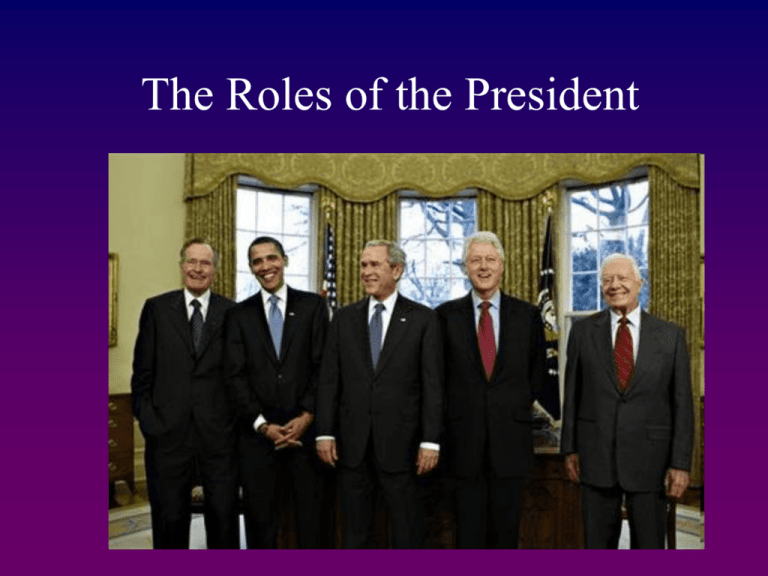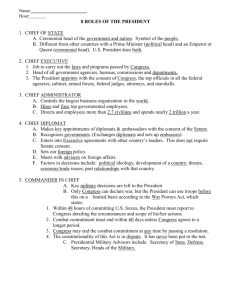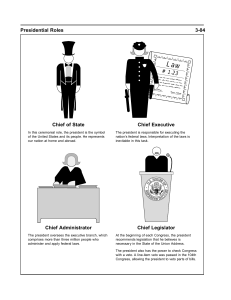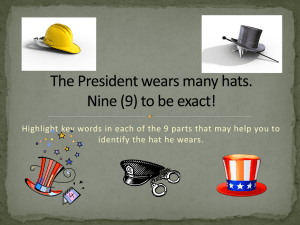The Roles of the President
advertisement

The Roles of the President Chief of State • Ceremonial head of the government and nation. Symbol of the people. • Different from other countries with a Prime Minister (political head) and an Emperor or Queen (ceremonial head). U.S. President does both. Chief Executive - Job to carry out the laws and programs passed by Congress. - Head of all government agencies, bureaus, commissions and departments. - The President appoints with the consent of Congress, the top officials in all the federal agencies, cabinet, armed forces, federal judges, attorneys, and marshals. Chief Administrator • A. Controls the largest business organization in the world. • B. Hires and fires top governmental employees. C. Directs and employs more than 2.7 million civilians and spends nearly 2 trillion a year. Chief Diplomat • A. Makes key appointments of diplomats & ambassadors with the consent of the Senate. • B. Recognizes governments. (Exchanges diplomats and sets up embassies). • C. Enters into Executive agreements with other country’s leaders. This does not require Senate consent. Chief Diplomat (cont.) • D. Sets our foreign policy. • E. Meets with advisors on foreign affairs. • F. Factors in decisions include: political ideology, development of a country, threats, economy/trade issues, past relationships with that country. • A. Key military decisions are left to the President • B. Only Congress can declare war, but the President can use troops before this on a limited basis according to the War Powers Act, which states: – 1. Within 48 hours of committing U.S. forces, the President must report to Congress detailing the circumstances and scope of his/her actions. – 2. Combat commitment must end within 60 days unless Congress agrees to a longer period. – 3. Congress may end the combat commitment at any time by passing a resolution. – 4. The constitutionality of this Act is in dispute. It has never been put to the test. Commander & Chief Commander & Chief C. Presidential Military Advisors include: Secretary of State, Defense Secretary, Heads of the Military. Chief Legislator • A. Develops a legislative program spelled out through public policies. • B. Sets the congressional agenda. • C. Sends a budget for Congressional approval or changes. • D. Sends messages along with bills on specific issues to Congress (executive staff and agencies may do this as well). • E. Has the power to veto. This can be overturned with a 2/3 vote in Congress. • F. President has requested line item veto. What is this and what problems can occur with it? – a. Allows President to cancel specific spending amounts in spending bills enacted by Congress. – b. Gives President too much power of the legislation process. – c. It is not granted in the Constitution. Would need an Amendment to have it. • G. Judicial Power include the power of clemency (mercy or forgiveness). These include the power to: – a. Pardon or forgive a crime, – b. Reprieve or postpone an execution sentence, – c. Commutation or the power to reduce the length of a sentence or amount of fine, – d. Amnesty or pardons to groups of people. THESE FIRST SIX ROLE OF THE PRESIDENT COME DIRECTLY FROM THE CONSTITUTION. Chief of Party A. Leader of the Democratic or Republican party. B. Helps plan the party’s future selection and election strategy. C. Patronage – political job appointments D. Party spokesperson (speaks at fundraisers) E. Campaign for self and others. Chief Citizen • A. The President is the representative of all the people of the U.S. – Our voice. • B. Media Power – Talk to the nation through radio and TV. • C. Represent the public interest against the many private interests. FORMAL QUALIFICATIONS OF THE PRESIDENT: A. Must be a natural born citizen of the U.S. B. Must be at least 35 years of age. C. Must have lived in the U.S. for at least 14 years. TERM OF THE PRESIDENT: • A. Agreed to be 4 years. Although at first there was no limit to the number of terms one could serve. • B. George Washington served only two terms and started the “no third term tradition.” • C. FDR sought and won a third and fourth term. The 22nd Amendment was passed limiting Presidents to serving two terms only. 1. A President may finish out a predecessor’s term and then seek two full terms but cannot be president more than 10 years. Presidential Perks Congress decides the President’s annual salary. • This salary cannot be changed while a President is in office. • The current salary, set in 2001, is $400,000 a year plus $50,000 a year for expenses. • The Constitution forbids the President from receiving any other pay from the government or the States while in office.







